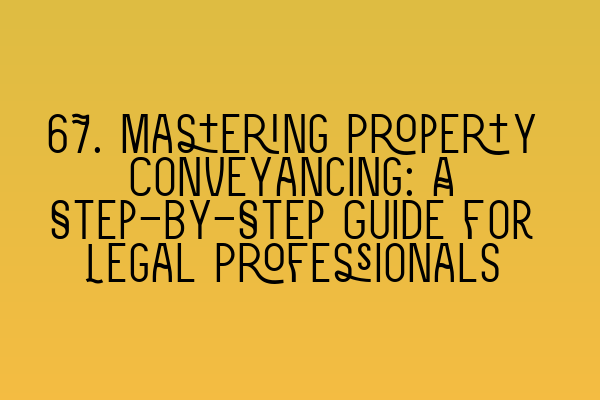Mastering Property Conveyancing: A Step-by-Step Guide for Legal Professionals
Welcome to SQE Property Law & Land Law! As a legal professional, mastering the intricacies of property conveyancing is essential in providing excellent service to your clients. In this comprehensive guide, we will walk you through the step-by-step process of property conveyancing, highlighting key points and providing useful tips along the way.
Step 1: Initial Client Meeting
Begin by scheduling an initial meeting with your client to discuss their property conveyancing needs. This is your opportunity to gather important information such as the type of property, its location, and the client’s desired outcomes. It is also important to explain the conveyancing process, timelines, costs, and any legal obligations involved.
For a more in-depth understanding of the initial client meeting, check out our article on SQE 1 Practice Exam Questions.
Step 2: Property Searches
Once you have a clear understanding of your client’s needs, the next step is to conduct property searches. These searches are crucial in uncovering any potential issues or restrictions that may affect the property’s title. Common searches include local authority searches, environmental searches, and water and drainage searches.
Learn more about property searches and their significance in our article on SQE 2 Preparation Courses.
Step 3: Reviewing Contracts
After conducting property searches, it’s time to review the contracts and legal documentation associated with the property. This includes examining the title deeds, property surveys, and any additional agreements between the buyer and seller.
Ensure you have the necessary knowledge to effectively review contracts with our article on SQE 1 Preparation Courses.
Step 4: Preparing and Exchanging Contracts
Once you have reviewed all the relevant documentation, it’s time to prepare the contracts for exchange. This involves drafting the necessary legal paperwork, including the sale and purchase agreements, and ensuring all terms and conditions are accurately reflected.
For a comprehensive understanding of contract preparation and exchange, see our article on SQE 2 Preparation Courses.
Step 5: Completion and Post-Completion Matters
On the completion day, all parties involved in the transaction meet to finalize the transfer of ownership and payment of funds. Following completion, there are post-completion matters that need to be attended to, such as registering the property with the Land Registry and dealing with any outstanding mortgage or charges.
Stay up-to-date with the SRA SQE Exam Dates for key milestones in the completion and post-completion processes by reading our article on SRA SQE Exam Dates.
Step 6: Finalizing the Transaction
Once all the necessary steps have been completed, you can now finalize the transaction by releasing the keys to the buyer and ensuring all legal and financial obligations have been fulfilled. It is also crucial to provide your client with all the relevant documentation and advice pertaining to their newly acquired property.
For further practice and mocks related to property conveyancing, check out our article on SQE 1 Practice Mocks FLK1 FLK2.
Conclusion
Mastering property conveyancing requires a thorough understanding of the step-by-step process and staying updated with the latest legal requirements. By following this guide, you are well-equipped to handle property conveyancing efficiently and effectively, providing your clients with exceptional service.
For more information, training, and resources related to property law and land law, visit SQE Property Law & Land Law. Our team of experts is always ready to assist you in becoming a proficient legal professional in property conveyancing.
